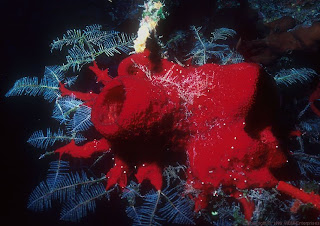The sea hare (Aplysia punctata) inhabits shallow waters near the British Isles. This hermaphrodite secretes ink as a means of defense when disturbed. The protein, cytotoxic cyplasin is produced by the sea hare and has been shown to initiate cell death. Cancer arises from uncontrolled cell proliferation and thus cancer treatments are designed to induce cell death. Cytotoxic cyplasin has the potential to be an effective cancer treatment and has been shown to kill tumors without harming the surrounding cells. In the future this protein may be used to treat skin cancer.[1] [2]
2. Bacteria, Salinispora tropica – Can Sediments Fight Bone Cancer?

The bacteria Salinispora tropica is found in ocean sediments off of the Bahamas and produces the anticancer compound salinosporamide A. This compound has been shown to treat the bone marrow cancer multiple myelinoma along with other solid tumors. This is a very useful organism because 10% of its genes produce antibiotics or anti-cancer agents.
[3]
3. Red Cup Sponge, Mycale sp. and Organ Transplants
Organ transplant recipients require treatments with drugs that suppress their immune systems. Immunosuppressants prevent the recipient’s body from rejecting the new organ. The molecule pateamine A is isolated from marine sponges of the genus Mycale. Pateamine A is an immunosuppressive agent that is so effective that scientists are currently working to manufacture it in large quantities for treating patients.[4]
4. Blue Green Algae, Cyanobacteria – Unlocking the Mystery of Neurons
 Cyanobacteria, a type of blue-green algae produces the compound nostocarboline. This compound has been shown to fight Alzheimer’s and other diseases that result in degeneration of the brain. Although there is currently no cure for Alzheimer’s, compounds that inhibit the enzyme cholinesterase, such as nostocarboline, have been shown to slow the progression of this disease. In addition, a second compound extracted from cyanobacteria known as kalkitoxin prevents neurons from generating electrical signals. Therefore kalkitoxin may be useful for understanding how neurons function and could also be used to develop new treatments for pain, epilepsy and stroke.[5] [6]
Cyanobacteria, a type of blue-green algae produces the compound nostocarboline. This compound has been shown to fight Alzheimer’s and other diseases that result in degeneration of the brain. Although there is currently no cure for Alzheimer’s, compounds that inhibit the enzyme cholinesterase, such as nostocarboline, have been shown to slow the progression of this disease. In addition, a second compound extracted from cyanobacteria known as kalkitoxin prevents neurons from generating electrical signals. Therefore kalkitoxin may be useful for understanding how neurons function and could also be used to develop new treatments for pain, epilepsy and stroke.[5] [6]5. Sea Coral, Bugula neritina - The Real Natural Cure
The sea coral Bugula neritina contains bacteria that have the potential to treat a variety of cancers. One product of the bacteria, Byrostatin 1, is an anticancer drug which can be passed through the larva of the Bugula neritina. Instead of simply killing cancerous cells, Byrostatin 1 changes how the cells function in the body. This drug is currently in clinical trials for humans but unfortunately, there is not yet a way of producing the amount of Byrostatin 1 necessary to treat the number of people suffering from cancer.[7]
cancers. One product of the bacteria, Byrostatin 1, is an anticancer drug which can be passed through the larva of the Bugula neritina. Instead of simply killing cancerous cells, Byrostatin 1 changes how the cells function in the body. This drug is currently in clinical trials for humans but unfortunately, there is not yet a way of producing the amount of Byrostatin 1 necessary to treat the number of people suffering from cancer.[7]
 cancers. One product of the bacteria, Byrostatin 1, is an anticancer drug which can be passed through the larva of the Bugula neritina. Instead of simply killing cancerous cells, Byrostatin 1 changes how the cells function in the body. This drug is currently in clinical trials for humans but unfortunately, there is not yet a way of producing the amount of Byrostatin 1 necessary to treat the number of people suffering from cancer.[7]
cancers. One product of the bacteria, Byrostatin 1, is an anticancer drug which can be passed through the larva of the Bugula neritina. Instead of simply killing cancerous cells, Byrostatin 1 changes how the cells function in the body. This drug is currently in clinical trials for humans but unfortunately, there is not yet a way of producing the amount of Byrostatin 1 necessary to treat the number of people suffering from cancer.[7] [1] Edmonton A. Cyplasin Biomedical Ltd Announces Second U.S. Patent for Cyplasin. 2007.
[2] D, Machuy N, Thiede B, Hurwitz R, Goedert S, Rudel T. 2004. Hydrogen peroxide produced by Aplysia ink toxin kills tumor cells independent of apoptosis via peroxiredoxin I sensitive pathways. Cell Death and Differentiation. 11: 608-17.
[3] Cancer Killer Found in the Ocean; marine biotechnologists treat cancer with mud-loving ocean bacteria. Science Daily. 2007. http://www.sciencedaily.com/videos/2007/1107%20cancer_killer_found_in_the_ocean.htm .
[4] Romo D, Li S, Shi Z, and Liu J Synthetic and Mechanism of Action Studies of Pateamine A and Congeners. http://www.chem.tamu.edu/iuccp/pdf/poster/Shukun%20Li.pdf
[5] Potent New compound from blue-green algae May Help Treat, Elucidate Nerve Disorders. Science Daily. 2000. http://www.sciencedaily.com/releases/2001/12/00122008347.htm.
[6] Natural Compound from ‘Pond Scum’ shows potential activity against Alzheimers. Science Daily 2005. http://www.sciencedaily.com/releases/2005/12/051227155255.htm .
[7] Marine bacteria a source for anti-cancer drug. GeneWorks. 2001. http://www.labonline.com.au/news/5430-Marine-bacteria-a-source-for-%20%20anti-cancer-drug .
Photos:
http://www.marine.csiro.au/crimp/nimpis/spImages.asp?txa=6929
http://www.sciencedaily.com/releases/2007/06/070613174715.htm
http://www.ramblincameras.com/Carspn8.htm
http://user.uni-frankfort.ed/~schauder/cyanos/cyanos.html
http://www.marine.csiro.au/crimp/nimpis/spImages.asp?txa=6929


1 comment:
Why is Byrostatin 1 so difficult to mass produce? Has the Byrostatin 1 gene been isolated yet?
Post a Comment